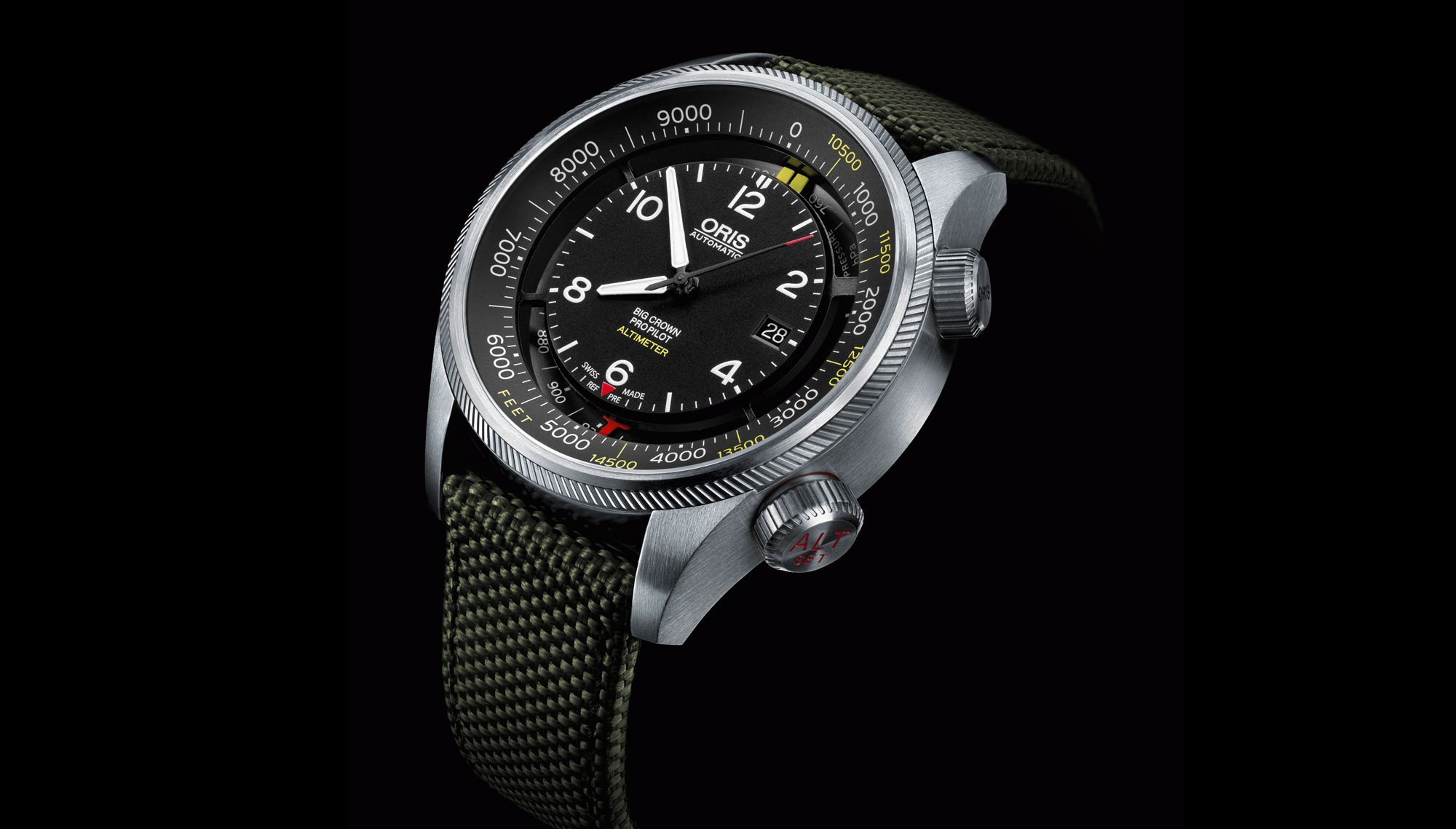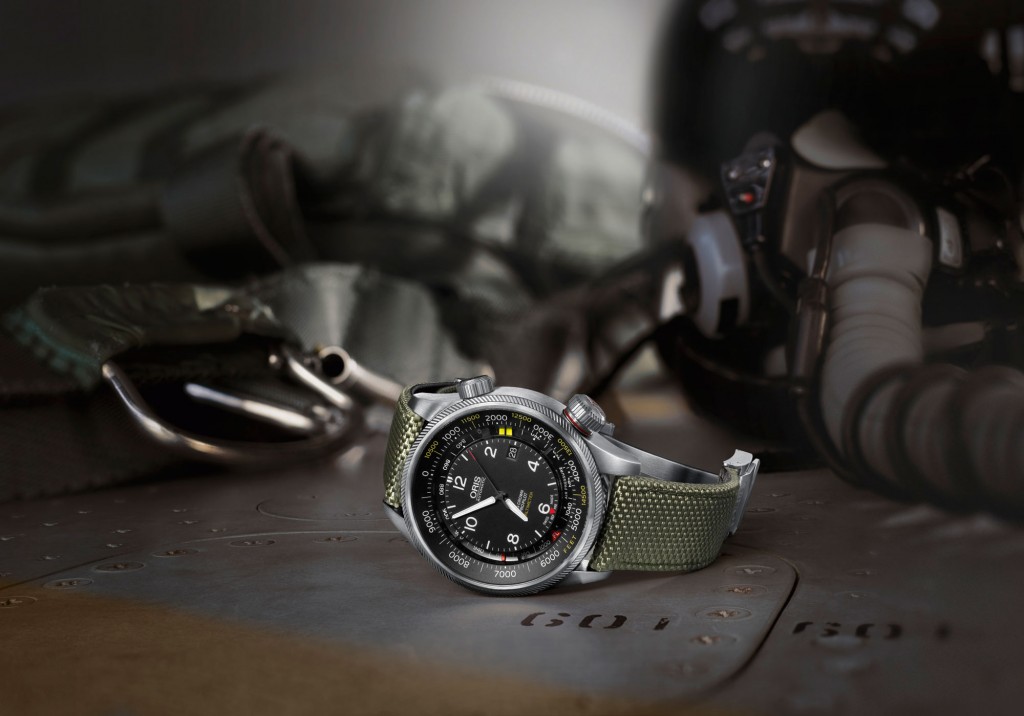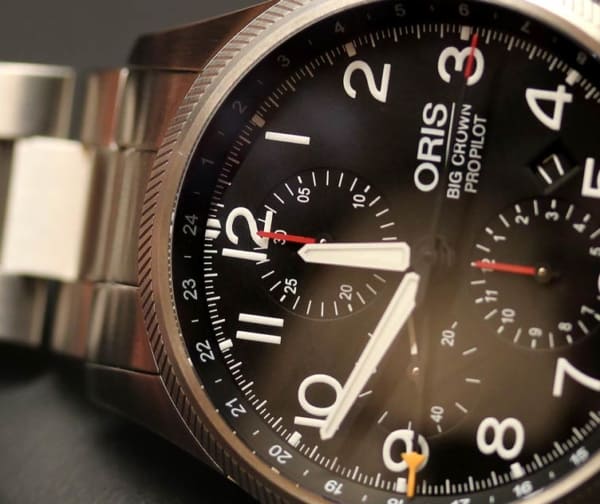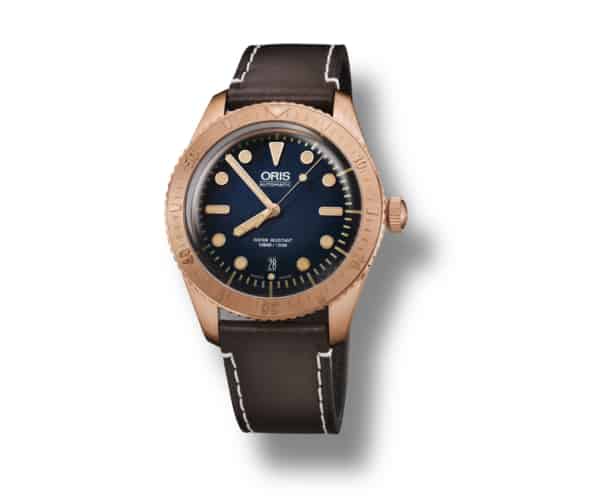Who on earth ‘needs’ a watch with an altimeter? ‘Wants’ is a different matter.
So there you are at 15,000ft, about to tip your Mk XVI Spit into a dive. You thumb the Merlin up to full boost then, casually – because you’re that sort of chap – you glance down to check your aircraft altimeter against your watch’s. Happens all the time, surely?
Oris have made a watch with a mechanical altimeter. Why? What on earth is the point? You know what – the ‘why’ doesn’t matter. After all, your local swimming bath is less than 3 metres deep, but you still wear a Sub. You probably don’t own a Formula 1 car but you wear a Tag Heuer F1. Chances are you’re not a pilot – but it doesn’t matter either because this watch is an Industry First.
Let’s look at the background…
The Oris Aviation Collection. Watches and aviation. It’s really a bit of a conceit. Modern (and even older planes) have all the built-in gadgetry you need to fly. You need a watch when you fly like you need a Sub when you dive. But that’s not the point. In fact, in Watchworld, practicality of function is seldom the point. Watchmakers don’t do it because it’s useful, they do it because they can.
The ProPilot Alti is the first watch with a mechanical altimeter built-in. But surely it’s easy to be a bit blase about an altimeter watch nowadays? After all, you can nip onto the web and pick up a Casio, a Timex, a Citizen or a Suunto that’ll tell you just how high you are. But this Oris is different…
Oris is one of the few independent watchmakers still run by the people who own it. They’ve been building proper mechanical watches in the Jura mountains since 1904. And the Hölstein business is one that’s run by enthusiasts, not people whose idea of a good time is counting beans.
The Oris ProPilot Altimeter is a properly clever piece of watchmaking. Not only will it tell you how high you are, it’ll tell you what the barometric pressure is too. That’s because the watch contains a wrist-sized mechanical pressure sensor. That’s clever as. Even cleverer is the altimeter indicator hand.
An altimeter is a chunky bit of machinery, so the indicator hand needed to be light and thin to save space and weight. But light and thin hands bend. And that makes them inaccurate. Unless, of course, you make them from laminated carbon fibre. This one is ten times stiffer than a standard, metal hand. Seven times lighter too. If that doesn’t give you a few bragging rights, nothing will. Told you this was a clever bit of watchmaking. Why don’t more makers do it?
So how does it work?
Shrug off your Irvin jacket, pull off your sheepskin flying boots, pour a decent measure and watch… Take your ProPilot Altimeter and unscrew the 2 o’clock crown (noticing that there’s also one at 4 o’clock). That’ll do all the normal gubbins of setting the time, date and initial winding.
Now, unscrew that 4 o’clock crown. When it’s screwed down, you have a case that’s water-resistant to 10 bar. Unscrew it and you can start using the altimeter. Notice how you can see a red ring on the crown’s shaft? Splendid. That’s important – remember it for later.
Now you’ve unscrewed the crown, you can calibrate the altimeter. Once done, you simply read altitude from the outer dial ring’s yellow indicator and scale and barometric pressure from the inner ring’s red scale and indicator. You can read up to 15,000 feet of altitude. If you’re feeling a little more metric, you can order a Ref. No. 733 7705 4164 TS with a metre scale. Then you can ask your batman to nip off and pour you a little refresher after all the hard work.
Now, remember that red ring? It shows you that the altimeter is working AND, when you’ve finished taking your reading, that the crown needs screwing in again to return the watch to its 100m/10 bar water resistant status.
With the case needing to be at least partially open to the air, water-resistance is a big deal for a mechanical barometer/altimeter watch. Oris have it nailed and have used a polytetrafluoroethylene (PTFE) membrane to keep moisture out and the case dry, even when using the altimeter. Otherwise a spilled G&T from the mess could do untold damage.
Inside the multi-part stainless 47mm case is a movement based on the Sellita SW200, a cal.733 in Orisspeak. That’s rather like an ETA 2824 for comparison. Solid, workmanlike, unbustable. 38 hour power reserve, automatic and easy parts availability for when it needs a service.
Sorry – what was that? How big? 47mm? That’s b-i-g. In fact, the Japanese had a Mk I anti-tank gun that fired shells the same diameter in WWII. This is not a small, unobtrusive watch in the same way that the Lancaster was not a small, unobtrusive bombing aircraft. But, like the Lanc, it carries its size and weight well. It’s intended to be a proper instrument too, so it gets away with its size. After all, a little 36mm thing isn’t going to cut it against all those cockpit lights.
Oris have, yet again, done that thing they do so well. They’ve built a watch that is different and engaging, designed and made by people who clearly give more than a damn at a price that doesn’t need a second mortgage. In fact, you can pick one of these beauties up for $3,700 with textile strap, $3,900 with metal bracelet from from September this year. Not cheap, sure, but a watchworld first for under $4k.
Oris have a knack of making gorgeous watches that are different from the rest of the ticking herd. They say this is “a high-performance instrument for pilots, mountaineers, explorers and research scientists, who work at altitude.” You may say “Meh. It’s just gorgeous anyway.”
The ProPilot is a gloriously over-the-top, beautiful piece of watchmaking. Who cares if you don’t really own that Spitfire?
by Mark McArthur Christie









 Featured Videos
Featured Videos











